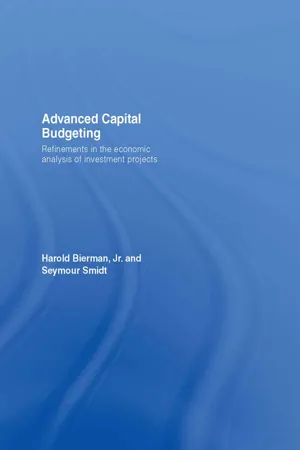
Advanced Capital Budgeting
Refinements in the Economic Analysis of Investment Projects
- 374 pages
- English
- ePUB (mobile friendly)
- Available on iOS & Android
Advanced Capital Budgeting
Refinements in the Economic Analysis of Investment Projects
About this book
Written by authors of established texts in this area, this book is a companion volume to the classic The Capital Budgeting Decision. Exploring this key topic in corporate finance the authors examine the complexities of capital budgeting as well as the opportunities to improve the decision process where risk and time are important elements.
Containing 'Global Aspects' sections that cover cross-border decision-making, this book also emphasizes the application of capital budgeting techniques to a variety of issues, including the hugely significant 'buy versus lease' decision that cost corporations billions each year.
It gives in-depth coverage to:
- real options - the value of a project must take into consideration the flexibility that it provides management, acknowledging the option of making decisions in the future when more information is available
- decomposing cash flows - a project consists of many series of cash flows and each series deserves its own specific risk-adjusted discount rate. Decomposing the cash flows of an investment highlights the fact that while managers are generally aware that divisions and projects have different risks, too often they neglect the fact that the cash flow components may also have different risks, with severe consequences on the quality of the decision-making.
Designed to assist those making business decisions at all levels, this volume is essential reading for all those working in or studying capital budgeting.
Frequently asked questions
- Essential is ideal for learners and professionals who enjoy exploring a wide range of subjects. Access the Essential Library with 800,000+ trusted titles and best-sellers across business, personal growth, and the humanities. Includes unlimited reading time and Standard Read Aloud voice.
- Complete: Perfect for advanced learners and researchers needing full, unrestricted access. Unlock 1.4M+ books across hundreds of subjects, including academic and specialized titles. The Complete Plan also includes advanced features like Premium Read Aloud and Research Assistant.
Please note we cannot support devices running on iOS 13 and Android 7 or earlier. Learn more about using the app.
Information
Capital budgeting and valuation under certainty
Well, I come down in the morning and I take up a pencil and I try to think.(Hans Bethe, quoted by Bob Herbert, New York Times, February 14, 2005, quoting from Timebends by Arthur Miller)
The state of the art of capital budgeting
Considering the accidents to which all human Affairs and Projects are subject in such a length of Time, I have perhaps too much flattered myself with a vain Fancy that these Dispositions will be continued without interruption and have the Effects proposed.(B. Franklin's Will)
In 1790, Franklin made a £2,000 gift to Boston and Philadelphia. £1,000 of the funds were to be spent after 1990. In 1990 the bequest was worth $6.5 million.(New York Times, April 21,1990. Author's note: Assuming the £1,000 was worth $4,000, the investment earned 0.03766 per year)
DECISION-MAKING AND CORPORATE OBJECTIVES
Table of contents
- Cover Page
- Half Title page
- Title Page
- Copyright Page
- Contents
- List of illustrations
- Preface
- Part I Capital budgeting and valuation under certainty
- Part II Capital budgeting and valuation under uncertainty
- Part III Option theory as a capital budgeting tool
- Part IV Applications of capital budgeting
- Name index
- Subject index